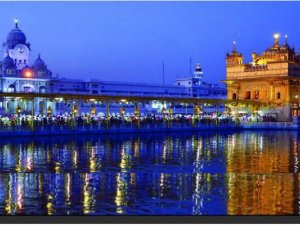I consider spirituality as the summum bonum of human life. For this reason, I attach a great importance to spirituality in my own life and the lives of others. Frankly, I would not hesitate to admit that I have a great passion for this field. The more I study this field, the more I am fascinated about it. It also seems that there are more questions than the answers for my quest.
However, I am also encouraged to note that in the new millennium, study of spirituality is rapidly gaining a great momentum, resurgence, and prominence in all fields in general, and in helping professions in particular. Since the discussion about the role of spirituality in counseling and psychotherapy is relatively new and the study of spirituality as a new field is just emerging, there seem to be many perspectives and few consensuses. I feel this lack of consensus makes the study of spirituality rather more fascinating and intriguing than limiting or confusing. New perspectives give a renewed sense of freshness.
As I was born and raised in a Sikh family in India, I would like to present my views from the perspective of the Sikh religion, a source of my personal knowledge and inspiration. I also plan to add my own ideas and views from my teaching experiences as well as research about spirituality in the United States.
He causes births but Himself is beyond it. He is self-illuminated. God can be reached by following the teachings of the Guru” (SGGS p.7).
The Teachings of Sikhism
Sikhism respects all religions provided they are in the name of God, the Supreme Being. As a Sikh, I strongly believe that any religion that does not respect another religion, it is not worthy of being called a religion. If Sikhism criticizes anything, it rejects meaningless rituals, symbolism, and formalism (Kohli, 1991).
Akal Purukh (God): According to Sikhism, God is the only ultimate reality. He is beyond birth and death. Fox (1983) presented four categories: theistic, atheistic, pantheistic and panentheistic, by which humans may conceptualize their relationship to God. I believe that Akal Purukh as described in Sikhism fits the category of panentheism in which God flows through all things, but also paradoxically transcends all things. Since He resides in all things, Nature is also sacred, not false or evil. Guru Nanak writes, “Nanak sache ke, sachi kaar.” He is true, and true is His creation.
Sikhism arose essentially as a Prophetic religion with a Divine Mission to usher a new, progressive value-system, social order, economic pattern and political setup, characterized by the ideals of justice, equality, democracy, republicanism and secularism. (Ahluwalia, p. 50, 1987). Sikhism believes more inversion than conversion of others. Sant Rajinder Singh points out, “We want to go within, because the treasure house of divinity is within ourselves (1995, p.251).”
I recognized four major aspects of Sri Guru Granth Sahib (Sandhu, in press). Of course, these four major aspects may also be present in other scriptures. These major aspects with some examples are briefly presented below:
- Special Rules for Living
In Gurbani, the Gurus asked the Sikhs to control kaam (lust,) krodh (anger,) lobh (greediness,) moh (worldly attachments,) and ahnkar (haughtiness) in order to live a simple and happier life. Of course, it is not possible to eliminate these five things altogether, but one should try to manage them.
Three major commandments for Sikhs include, Naam japna (Meditate on God’s name or worship God,) Kirat Karna (earn your livelihood,) and vand chhakna (share with the needy.) A significant emphasis is also placed on the service called “sewa” for others.
Guru Nanak was a practical idealist who preached, “Truth is high, but higher still is truthful living (SGGS, p. 38). Sikhs are expected to live a moral, simple, and a truthful life bravely. They are also asked not to fear and frighten others. “Bhai kahu ko det neh, neh bhai manata aan” (SGGS, p. 1427). *
In Sikhism, all people are equal. No body is inferior or superior due to their caste, color, and creed. Ek pitta, eks ke ham barak (SGGS, p. 611). (Our Father is One, and we all are His children) or Aval Allah noor upaya, kudrat ki sabh bande. Ek noor te sabh jag upje, kaun bhalle, kaun mande (SGGS, p. 1349).(Almighty God has produced us all from the same light, how some could be superior or inferior). Such lines are repeated in the SGGS. It is our actions that make us good or bad.
Guru Nanak also strongly believed in the equality of sexes. Speaking of women, he wrote: So kiun manda aakhye, jit janme rajan. ( SGGS, p. 473) Why revile women who gave birth to the kings and prophets?
- Gurbani for Emotional Solace
There are several lines in Sri Guru Granth Sahib that provide psychological comfort. Over and over again, Gurbani reminds us that our faith in Him is the answer to all our human problems. When we are helpless, acceptance of His will and turning ourselves to God for His Help is the only and ultimate solution.
Jaako mushkal aat bane, dhoie koi na de.
Laagu hoi dushmana, saak bhi bhaj khale.
Chuke sabho asra, chuke sabh aasrao.
Chit aave jis Parbrahm, ta laage na tatti vaau.
If a person can discipline his mind, he or she can win the whole world. Psychological peace can be attained only through harnessing our fickle mind. Mann jeete jag jeet (SGGS, p. 6).
“Nanak dukhia sabh sansar ( SGGS, p.954 ) The whole world is in pain, says Nanak. There is a comfort knowing that our problems are a part and parcel of human life and all people have them.
- Aesthetical Appreciation of God and His creation.
Sri Guru Granth Sahib is wholly devoted to the praises of the Waheguru (Wonderful God). It is written in musical poetry and meant to be sung. Guru Nanak himself sang in various Ragas (musical patterns) to the accompaniment of musical instrument called Rabab which was played by his musician, Mardana. This spiritual poetry addressed to God and His appreciation is quite moving, powerful, and uplifting. Unfortunately, its exhilaration, celestial, and musical qualities are lost in translation. Hymns in Sri Guru Granth Sahib are rich with devotional fervor whose inspiration and musical appeal is irresistible to the human spirit. On a personal note, hearing the following lines have always brought me ecstatic tears.
Mil mere Pritma jio
Tudh binnan khari mein nimani.
O, Beloved God, please let me see you.
Without you, I am standing here alone helplessly.
Spiritual poetry in Guru Granth Sahib is mostly written as the devotee’s direct communication with God Himself. In the vein of Sufism, this communication is filled with pining love (Bhakti) as a dialogue between a beloved and her lover. This represents a zenith of human devotion for an ascent to the Almighty God.
- Spiritual path to Unite with God
According to the Sikh Gurus, the main purpose of life is the attainment of the spiritual substratum, the divine awareness that is present in all humans (Sethi, 1998). Guru Nanak described five progressive stages of spiritual ascent in his Japji. Through these five realms called khands, the ultimate goal of all spiritual endeavors is to transcend the experience of Righteous Action (Dharma,) Illumination (Gian, Jnan,) Grace (Karam,) Spiritual Endeavor (Sarm, Sram) and to enter Sach Khand (The Realm Eternal) eternally to abide in the Divine presence (Talib, 1984.) The ultimate exhilarating spiritual experience, the truest bliss of union with the Supreme, is called Sanjog, the ultimate union or immersion of human soul with God.
A Brief History of Sikhism
Human history is sadly ironic. Great persons whoever stood for truth or preached the message of love and peace, they never could experience peace themselves in this world. Such great persons have been poisoned to death or crucified.
The Sikh spiritual Gurus were no exception. The oppressive regimes of fanatical and tyrant Mogul emperors of India of the time, took Gurus as a threat to Islam. Incidentally, as history would have it, the Mogul dynasty and the succession of the ten Sikh Gurus ocurred simultaneously, the former as the political, the latter as the spiritual power.
Fifth Guru Arjun was roasted alive on the hot pan, for not changing some lines in the Sri Guru Granth Sahib that Emperor Jahangir thought derogatory to Islam. The ninth Guru, Teg Bahadur was beheaded in Delhi for refusing conversion. The tenth Guru, Gobind Singh was stabbed, his mother (Mata Gujari) was frozen to death, his two older sons were killed on the battleground and his two younger sons, ages 7 and 9 years, were buried alive in a wall for not embracing Islam.
The history of the Sikhs is written in blood. All its pages are studded with the innumerable sacrifices and untold number of names of martyrs, called Shahids. Sikhs were beheaded (Taru Singh,) boiled in a Cauldrum (Bhai Dayla,) sawed (Bhai Matti Dass,) cut to pieces (Manni Singh) and burnt alive (Bhai Satti Dass) because they stood fast for their beliefs in Sikhism.
It is unfortunate that in the name of the religion, so many atrocities have been inflicted on the innocent people. One of the many shocking such examples in Sikhism is the torture of Banda Singh Bahadur. After his four sons were slaughtered in his lap, Banda was forced to eat the heart of his own son.
In the face of such cruelties and religious persecution, Guru Gobind Singh created Khalsa (the brotherhood of the pure) to fight back, and described his followers as saint soldiers. Guru Gobind’ Singh’s admonition, “When all pleas for justice fail, it is cowardess not to pick up a sword and fight.” instilled a new spirit of bravery in the oppressed masses.
Names of Sikh heroes such as Shahid Baba Deep Singh, Hari Singh Nalwa, Akali Phulla Singh, and Sikh Emperor Maharaja Ranjit Singh, etc. are matchless examples of bravery in the Sikh history. These great men fought bravely and successfully for religious freedom for the masses in India.
I would like to conclude this section with Ek Ong Kaar Kaur Khalsa’s (2002) observations. She claims that Guru Nanak was the first post-modern scholar. He was centuries ahead of his time in his view of language, culture, the natural world and God. “In fact, he is the perfect guide for the post-modern person because post-modernism leaves people feeling empty, that life is without meaning. But Guru Nanak takes the deconstruction of post-modernism and then says: see, at the heart of it there is amazing creative play that we can’t comprehend or define.
THAT, my friends is God. And if you meditate and be what God created you to be, then it is a natural, human, normal experience to have a conscious relationship with God.” Impressed by the observations of many scholars, like Ek Ong Kaar Kaur Khalsa Ji, I concluded that Sikhism is really the post-modern religion of the world (Sandhu, in press.)
Editor's Note: These articles will be published during the first week of February, 2017. Please check back for more installments.
Other Articles in this Series:
Part 2 – My Perspectives on Spirituality
Part 3 – Spirituality in Counseling and Psychotherapy
Part 4 – The Experiental Stages of Spirituality
Part 5 – Spiritual Strategies of the Sikhs





